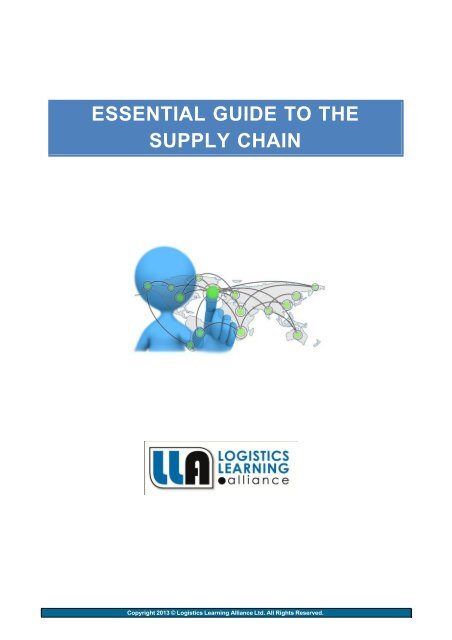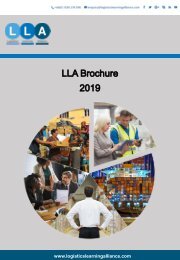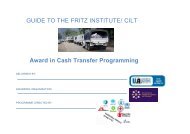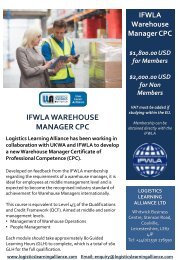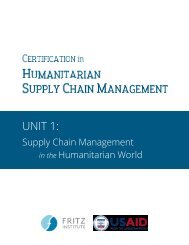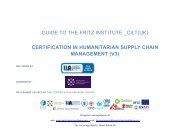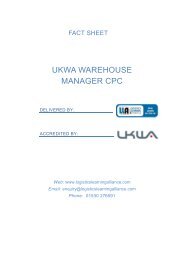You also want an ePaper? Increase the reach of your titles
YUMPU automatically turns print PDFs into web optimized ePapers that Google loves.
ESSENTIAL GUIDE TO THESUPPLY CHAIN
Copyright StatementAll rights reserved. No part of this publication may be reproduced or transmitted in any formor by any means electronic or mechanical, including pho<strong>to</strong>copying, recording, broadcasting orby any o<strong>the</strong>r information s<strong>to</strong>rage and retrieval system without written permission from <strong>the</strong>Logistics Learning Alliance Limited.
WHAT IS THE PURPOSE OF THIS GUIDE?This guide is structured in a way that will give you anoverview of supply chain principles. The purpose of<strong>the</strong> guide is <strong>to</strong> create an awareness of <strong>the</strong> keycomponents of <strong>the</strong> supply chain. It is not designed <strong>to</strong>give you an in-depth knowledge and understanding of<strong>the</strong> subject.You will find <strong>the</strong> guide a useful introduction <strong>to</strong> <strong>the</strong> areaof supply chain. It will give you a broadunderstanding of how effective supply chainmanagement supports, and helps deliver, anorganisation’s business strategy.The guide begins by explaining <strong>the</strong> fundamentals ofsupply chain management and how a supply chainworks. The way in which product and information flows through <strong>the</strong> supply chain is examined.Attention is paid <strong>to</strong> <strong>the</strong> issue of complexity and <strong>the</strong> importance of visibility in <strong>the</strong> supply chainis demonstrated.A number of basic concepts are explained and <strong>the</strong>se set <strong>the</strong> framework for <strong>the</strong> final part of <strong>the</strong>guide, which deals with performance measurement and supply chain improvement.Performance needs <strong>to</strong> be measured both within organisations and between organisations in asupply chain. A number of metrics are listed, leading <strong>the</strong> reader <strong>to</strong> <strong>the</strong> final part of <strong>the</strong> guide,namely <strong>the</strong> targeting of potential areas of supply chain improvement. Major benefits canaccrue through <strong>the</strong> identification and exploitation of such improvement opportunities. Theguide suggests some of <strong>the</strong> areas that will deliver benefit for organisations.
WHAT IS A SUPPLY CHAIN?At first glance <strong>the</strong>re is nothing really complicated about a supply chain. If you are going <strong>to</strong> sellsomething, <strong>the</strong>n clearly it must be made and <strong>the</strong>n delivered <strong>to</strong> <strong>the</strong> cus<strong>to</strong>mer. Of course <strong>the</strong>difficulty of <strong>the</strong> task will depend on <strong>the</strong> product complexity; a car is much more complex than apen. The location of <strong>the</strong> cus<strong>to</strong>mer will also help or hinder; reaching a cus<strong>to</strong>mer in Londonfrom your distribution centre in Holland will clearly be easier than reaching <strong>the</strong> cus<strong>to</strong>mer inVladivos<strong>to</strong>k.Start <strong>to</strong> explore what lies behind <strong>the</strong>se simple activities and it does not take long <strong>to</strong> realise that<strong>the</strong> costs of supporting <strong>the</strong>m could vary greatly from one company <strong>to</strong> <strong>the</strong> next. And of coursehow well you perform <strong>the</strong> activities will surely determine whe<strong>the</strong>r <strong>the</strong> cus<strong>to</strong>mer returns <strong>to</strong> buysome more. Getting it right <strong>the</strong>refore could have a dramatic impact on <strong>the</strong> success of anorganisation.The simplest supply chain is one where <strong>the</strong> consumer places an order and <strong>the</strong>re is sufficienttime available <strong>to</strong> enable <strong>the</strong> fac<strong>to</strong>ry <strong>to</strong> make and deliver <strong>the</strong> product. If <strong>the</strong>re were also timeavailable for suppliers of parts or components <strong>to</strong> also deliver <strong>the</strong>n <strong>the</strong> supply chain wouldneed no inven<strong>to</strong>ry at all. This would be a true Make <strong>to</strong> Order supply chain.A Simple <strong>Supply</strong> <strong>Chain</strong>
Gradually complexity gets added. Consumers require product <strong>to</strong> be available when <strong>the</strong>y wantit and so Points of Sale (such as retailers) get added. In time <strong>the</strong> retailers create distributioncentres <strong>to</strong> supply <strong>the</strong>ir outlets. As <strong>the</strong> retailer becomes more demanding <strong>the</strong> supplier decides<strong>to</strong> create <strong>the</strong>ir own distribution centre holding inven<strong>to</strong>ry of finished products. Later <strong>the</strong>y add amaterials warehouse <strong>to</strong> ensure supply of materials for <strong>the</strong> production line. Finally, suppliers<strong>to</strong>o may choose <strong>to</strong> hold inven<strong>to</strong>ry in a warehouse <strong>to</strong> meet <strong>the</strong> demands of <strong>the</strong> fac<strong>to</strong>ry.Adding ComplexityComplexity is created for a variety of reasons:To overcome uncertainty and variability withinprocessesTo aid <strong>the</strong> maximisation of fac<strong>to</strong>ry capacity utilisationTo improve delivery reliabilityTo reduce <strong>the</strong> risk of product becoming obsolete or passing <strong>the</strong> sell bydate.To overcome <strong>the</strong> lack of trust between supply chain partnersTo aid <strong>the</strong> maximisation of transport capacityutilisation
To facilitate <strong>the</strong> attainment of functional objectivesTo compensate for long cycle timesTo enable product <strong>to</strong> made in efficient batchsizesTo protect against <strong>the</strong> variability in demandTo compensate for <strong>the</strong> seasonality in demand and/orsupplyTo minimise fac<strong>to</strong>ry changeover costsTo overcome <strong>the</strong> lack of informationTo provide product varietyTo minimise <strong>the</strong> impact of poorcommunicationTo protect against <strong>the</strong> inaccuracy of forecastsTo allow silo thinking instead of processthinking.Most of all complexity gets added <strong>to</strong> ensure product is available <strong>to</strong> <strong>the</strong> next stage of <strong>the</strong> supplychain. Product availability is <strong>the</strong> key linking <strong>the</strong>me for supply chain management.WHAT IS SUPPLY CHAIN MANAGEMENT?<strong>Supply</strong> chain management commences with understanding consumer demand. This is <strong>the</strong>demand that arises from <strong>the</strong> actual use of <strong>the</strong> product. Cus<strong>to</strong>mer demand may be differentin that this arises from your immediate cus<strong>to</strong>mer, such as a retailer, before it is <strong>the</strong>n sold <strong>to</strong>a consumer.At <strong>the</strong> o<strong>the</strong>r end of <strong>the</strong> chain is supply. Again this can be taken back as far as possible <strong>to</strong><strong>the</strong> providers of materials or <strong>to</strong> growers.<strong>Supply</strong> chain management is about connecting this supply <strong>to</strong> <strong>the</strong> demand.
There are a number of flows:The primary goods flow connects supply <strong>to</strong> demand. During this flow product maychange format several times from raw material, in<strong>to</strong> work in progress beforebecoming a finished product.There is also a reverse goods flow, covering <strong>the</strong> return of defective product or<strong>the</strong> recycling activity.Finally <strong>the</strong>re are information flows that act as a trigger <strong>to</strong> <strong>the</strong> activity (<strong>the</strong> consumer order)and accompany <strong>the</strong> product <strong>to</strong> control and moni<strong>to</strong>r <strong>the</strong> flow.To receive <strong>the</strong> full length version of this guide, please complete our online format <strong>the</strong> following link http://bit.ly/1lEFZdJFor more information about <strong>the</strong> courses LLA provide, please contact us;Call 0800 158 8231 or Skype admin_llaEmail enquiry@logisticslearningalliance.com, visit www.logisticslearningalliance.comor Search for ‘Logistics Learning Alliance’ on LinkedIn, Twitter and Facebook.


